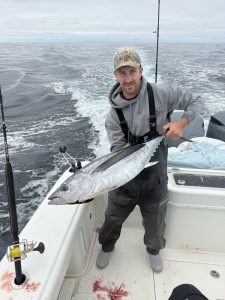Check out our Astoria Fishing Guides and Halibut Fishing Charters Washington
So you’re in the market for a new boat?
There are a lot of decisions to be made when buying that new boat and some of this can be a little intimidating. You need to figure out how much you’re going to spend, whether you’re going to buy new or used, what length, hull material etc. Just the process of researching all of these things can make buying a boat either a lot of fun, or a lot of work, depending on your perspective.
In an effort to make a little bit of this easier, let’s break down one of the most frequently asked questions by a new fishing boat buyer here in the Northwest, “Should I buy a tiller handle, or a steering wheel boat?”
There are advantages and disadvantages to both of these styles, and depending on where you fish, how you fish, and what size of boat you’re buying, making the wrong decision here can at a minimum create significant frustration or possibly even require an upgrade to another vessel after a short period of time.
Let’s start with breaking down the pros and cons of forward helm – steering wheel boats.
Advantages of the forward helm steering wheel boat:
Forward helm boats almost always have a windshield.
The wind and wave breaking ability of a windshield is a must if you are planning on fishing in less than ideal (rough) conditions on large bodies of water like the ocean or Great Lakes. When the boat noses into a wave or has a big one break over the bow, the windshield has the ability to shed that water down the side and out of the boat.
Safer and more maneuverable at high speeds.
At high speeds, (30+ mph) having the mechanical advantage of a steering wheel is highly preferred over having to hold onto a tiller handle especially when needing to corner hard.
In a tight turn, the steering wheel gives you something to hold onto and being in a seat gives you the personal safety and stability that isn’t available with a tiller handle.
Steering wheels are a lot less physical work than a tiller handle.
Find me a person that just drove a tiller handle boat 15 miles in rough water and I will show you someone that is wound as tight as a top and is sore! There is no comparison when measuring the level of fatigue after running long distances driving a tiller vs. a steering wheel. The steering wheel boat beats the tiller hands down for long distance comfort.
Remember large tiller handle boats are typically driven standing up so the captain can see what obstacles must be avoided, large boats are only driven from the seated position when it is relatively calm, and most of the time not even then. Standing while driving creates this constant balancing act for the captain who has little if anything to brace himself against, and over long distances this really takes it’s toll on the body and mind.
The fellow driving the steering wheel boat arrives relatively fresh and ready to fish but the poor guy in the tiller handle boat just got beat up, isn’t that happy, and isn’t looking forward to the run back, nor is he looking forward to doing this kind of thing for days on end!
Driving from a forward helm allows for increased visibility.
Forward helm boats allow you to see better and pick your way through tight spots with a little more finesse than if you were driving from the back of the boat.
For example, I would never want to run big white water like the Deschutes or Rogue Rivers from a tiller handle boat! I know guys that do but some of them have also told me that the big inboard forward helm jet boats are the best way to go in water like this.
The distance between the boat’s steering wheel and the back of the boat is about 20 feet so if you’re driving in the front of a 24 foot boat you are going to be able to see the rocks you need to avoid hitting 20 feet before you would be able to see them if you were driving from the back of the boat.
To put this in perspective, this is approximately a half a second advantage when driving at 30mph;driving from the front gives you a half a second better reaction time than driving from the rear.
Diesel, gas, inboard, and outboard power are all options in a steering wheel boat.
Tiller handle boats are almost exclusively outboard power; diesel and inboard power aren’t available or aren’t realistic options .
Driving a boat with a steering wheel is fairly intuitive for most people.
It’s like driving a car, turn the wheel to the right and the boat goes to the right. If folks have driven a car then they understand how the boat is going to react.
Multiple helm locations.
In larger ocean going boats there are often primary and secondary driving locations which allow the captain to drive from inside the cabin or to be outside on the back deck closer to the action or up above in the tower looking for fish.
The captain can talk while driving.
Not only can the captain converse with the other passengers, but he can actually be heard as well. Being away from the motor’s noise and often sheltered behind a windshield creates a much quieter ride. Forget about much conversation while driving a tiller handle.
Disadvantages of the forward helm steering wheel configuration:
Increased maintenance.
The working components of the steering mechanism require a modest amount of maintenance, whereas a tiller handle setup requires almost none. Maintenance such as bleeding and topping off hydraulic steering fluid and greasing the moving parts on the steering shaft or cable. There isn’t much expense associated with this maintenance, however it is something that has to be taken care of a few times a year.
Not as maneuverable at low speeds.
This is due to the inability of the steering wheel to be able to move the motor from full left to full right and back again rapidly. This is of primary concern when docking. Other than having bow thrusters there is just no beating a tiller handle when you’re taking a boat in and out of the slip.
Having the steering location in the front of the boat means you are often removed from the back of the boat where all the action is happening.
Driving from the front of the vessel really takes you out of the game. Your away from most of the conversation and excitement that is happening on the back deck, while some captains may enjoy getting away from the chaos, others may feel that their duties as captain aren’t nearly as fun from up in the front of the boat.
The steering location takes up a moderate to substantial amount of room in the vessel.
If you are restricted to buying a smaller boat, but you still really want to be able to comfortably take more than three or four passengers then you’re going to find the steering wheel is taking up the location of at least one seat. Take out both the windshield and the steering helm and you add seating space for up to two anglers.
Steering components, especially hydraulic steering, add significant initial cost.
The steering console, hydraulic mechanism, and cables can add up to more than $2000 whereas an aftermarket tiller handle setup can be had for around $300-$500.
Driving from the front of the boat is rougher because of the pounding the front of the boat receives.
While driving from the front of the vessel gives the captain greater forward visibility and an enhanced reaction time, one major downside is that the front portion of the vessel is where all of the pounding takes place. The front dead-rise of the boat is what impacts and breaks the waves, and the captain is seated very close to where the impact is happening. When the weather is bad and the seas are rough the forward part of the boat is not a pleasant place to sit.



